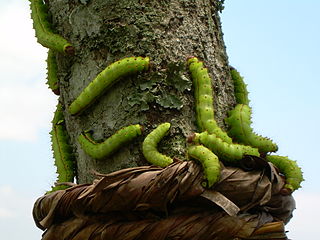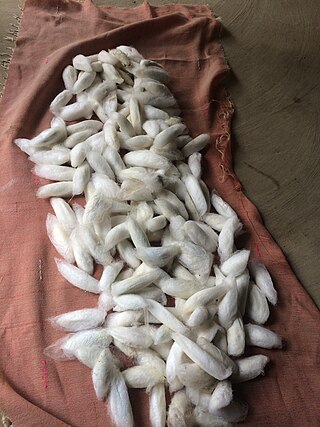
The domestic silk moth is an insect from the moth family Bombycidae. It is the closest relative of Bombyx mandarina, the wild silk moth. The silkworm is the larva of a silk moth. The silkworm is of particular economic value, being a primary producer of silk. A silkworm's preferred food is white mulberry leaves, though they may eat other species of mulberry, and even leaves of other plants like the osage orange. Domestic silk moths are entirely dependent on humans for reproduction, as a result of millennia of selective breeding. Wild silk moths are not as commercially viable in the production of silk.

Bombykol is a pheromone released by the female silkworm moth to attract mates. It is also the sex pheromone in the wild silk moth. Discovered by Adolf Butenandt in 1959, it was the first pheromone to be characterized chemically.

Bombyx is the genus of true silk moths or mulberry silk moths of the family Bombycidae, also known as silkworms, which are the larvae or caterpillars of silk moths. The genus was erected as a subgenus by Carl Linnaeus in his 10th edition of Systema Naturae (1758).
Flacherie is a disease of silkworms, caused by silkworms eating infected or contaminated mulberry leaves. Flacherie infected silkworms look weak and can die from this disease. Silkworm larvae that are about to die from Flacherie are a dark brown.

The Silkworm is a 2014 crime fiction novel written by J. K. Rowling, and published under the pseudonym Robert Galbraith. It is the second novel in the Cormoran Strike series of detective novels and was followed by Career of Evil in 2015, Lethal White in 2018,Troubled Blood in 2020 and The Ink Black Heart in 2022.

The Bombycidae are a family of moths known as silkworm moths. The best-known species is Bombyx mori (Linnaeus), or domestic silk moth, native to northern China and domesticated for millennia. Another well-known species is Bombyx mandarina, also native to Asia.

Bombyx mandarina, the wild silk moth, is an insect from the moth family Bombycidae. It is the closest relative of Bombyx mori, the domesticated silk moth. The silkworm is the larva or caterpillar of a silk moth. Unlike the domesticated relative which is unable to fly or indeed persist outside human care, the wild silk moth is a fairly ordinary lepidopteran. Its main difference from the domesticated taxon is the more slender body with well-developed wings in males, and the dull greyish-brown colour.

Wild silks have been known and used in many countries from early times, although the scale of production is far smaller than that from cultivated silkworms. Silk cocoons and nests often resemble paper or cloth, and their use has arisen independently in many societies.

Eri silk is the product of the domesticated silkworm Samia ricini, found mainly in North East India and some part of China and Japan. It was imported to Thailand in 1974. The name "eri" is derived from the Assamese word "era", which means "castor", as the silkworm feeds on castor plants. Another type of eri silk is "Ailanthus silk moth", refers to the host plant, Borkesseu, Ailanthus excelsa, practiced in China. Eri silk is also known as endi or errandi in India. The woolly white silk is often referred to as the fabric of peace when it is processed without killing the silkworm. This process results in a silk called Ahimsa silk. Moths leave the cocoon and then the cocoons are harvested to be spun. The eri silkworm is the only completely domesticated silkworm other than Bombyx mori.
Sericin is a protein created by Bombyx mori (silkworms) in the production of silk. Silk is a fibre produced by the silkworm in production of its cocoon. It consists mainly of two proteins, fibroin and sericin. Silk consists of 70–80% fibroin and 20–30% sericin; fibroin being the structural center of the silk, and sericin being the gum coating the fibres and allowing them to stick to each other.

Antheraea pernyi, the Chinese (oak) tussar moth, Chinese tasar moth or temperate tussar moth, is a large moth in the family Saturniidae. The species was first described by Félix Édouard Guérin-Méneville in 1855. Antheraea roylei is an extremely close relative, and the present species might actually have evolved from ancestral A. roylei by chromosome rearrangement.
The Bombyx hybrid is a hybrid between a male Bombyx mandarina moth and a female Bombyx mori moth. They produce larvae called silkworms, like all species of Bombyx. The larvae look a lot like the other variations. They are brown in the first half and gray at the bottom half, but they get larger black spots than other variations. Generally, they look like a normal Bombyx moth, but a bit darker. Hybrids are not used for silk, but for research. Because Bombyx mori males lost their ability to fly, their females are much more likely to mate with a male Bombyx mandarina. The reverse is possible, but both species have to be kept in the same container. Since Bombyx hybrids are much more common than the other variation, more is known about them.
The Bombyx second hybrid is a cross between a male Bombyx mori moth and a female Bombyx mandarina moth. Since the male Bombyx mori does not fly, it is completely dependent on humans to reproduce. They produce larvae called silkworms, like all species in Bombyx, except they are brownish in the first half and grayish at the bottom half. They produce silk and give out black droppings.

Bombyx huttoni, or the chocolate-tipped silk moth, is a moth belonging to the silk moth family, Bombycidae. It is closely related to the domestic silk moth.
In molecular biology mir-305 microRNA is a short RNA molecule. MicroRNAs function to regulate the expression levels of other genes by several mechanisms.
In molecular biology mir-275 microRNA is a short RNA molecule. MicroRNAs function to regulate the expression levels of other genes by several mechanisms.

Bidensovirus is a genus of single stranded DNA viruses that infect invertebrates. The species in this genus were originally classified in the family Parvoviridae but were moved to a new genus because of significant differences in the genomes.
A micropyle is a pore in the membrane covering the ovum, through which a sperm enters. Micropyles are also found in sporozoites of some digenetic microorganisms such as Plasmodium at the anterior part of the cell that ultimately leads towards the apical cap. Examples of other organisms that have micropyles are the Bombyx mandarina and the Ceratitis capitata.
Semotivirus is the only genus of viruses in the family Belpaoviridae. Species exist as retrotransposons in a eukaryotic host's genome. BEL/pao transposons are only found in animals.











